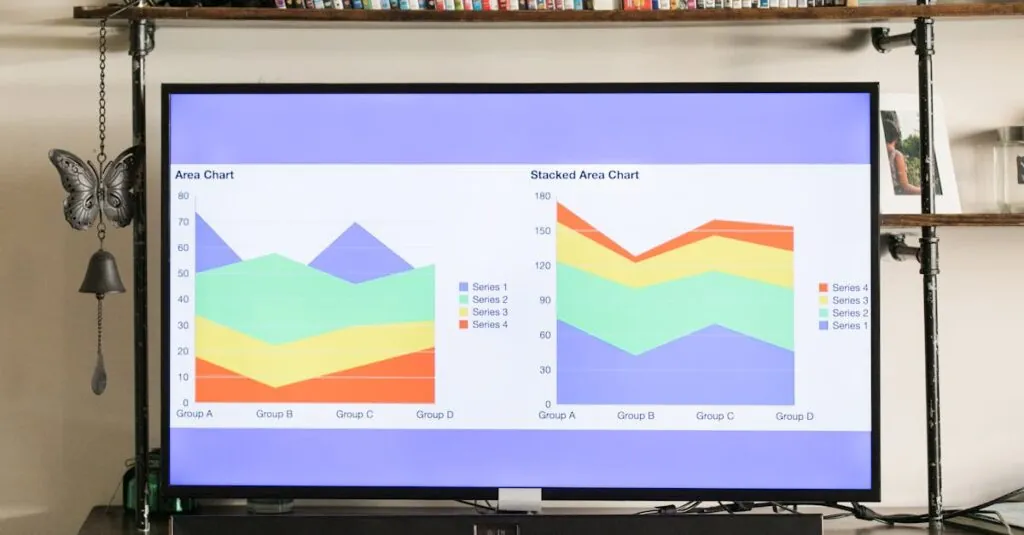Table of Contents
ToggleIn a world overflowing with gadgets and gizmos, making the right tech choice can feel like navigating a maze with a blindfold on. Whether it’s smartphones, laptops, or smart home devices, the options are endless, and each claims to be the best thing since sliced bread. But let’s be honest—who has time to sift through endless reviews and specs?
Overview Of Tech Product Comparisons
Tech product comparisons serve as essential tools for consumers navigating today’s diverse technology landscape. Evaluating different devices helps users understand which options best fit their needs. Smartphones, laptops, and smart home devices showcase a multitude of features, making side-by-side analyses valuable.
Many tech enthusiasts rely on comparison websites and specialized blogs to gather detailed information. These resources often highlight specifications, user reviews, and performance data. By presenting multiple products together, consumers can pinpoint variations in battery life, processing power, or design elements.
Understanding key specifications plays a crucial role in making informed decisions. For example, comparing RAM sizes in laptops can indicate multitasking capabilities. Similarly, exploring camera features in smartphones reveals significant differences in image quality.
Features like connectivity options and operating systems contribute to personal preference. Contrasting operating systems such as iOS and Android can help users determine which device aligns with their familiar usage patterns. By evaluating these factors, they can select products that meet their specific requirements.
Tech product comparisons also showcase price ranges, helping consumers find budget-friendly solutions. Evaluating value becomes easier when determining how much performance and functionality align with cost. Whether considering entry-level options or high-end devices, comparisons clarify what consumers gain at each price point.
Utilizing tech product comparisons fosters confidence in purchase decisions. As consumers weigh their options, these analyses provide clarity and direction in an otherwise overwhelming market. Engaging with this information can lead to smarter, more satisfying tech choices.
Popular Categories For Comparison
Tech product comparisons benefit consumers by simplifying choices in a crowded market. Popular categories that often require careful evaluation include smartphones, laptops, and wearable devices.
Smartphones
Smartphones rank among the most sought-after tech products. They come with various features like camera quality, battery life, and screen size. Users can assess options based on specifications such as processor speed, storage capacity, and connectivity. Different operating systems, including iOS and Android, influence preferences. Price points also vary significantly, enabling consumers to find models that fit their budgets while meeting performance expectations.
Laptops
Laptops present a wide array of choices for users ranging from casual to professional. Key specifications, including RAM size, storage type, and graphics capabilities, contribute to performance levels. Factors like portability, battery life, and display quality also matter greatly. Comparisons often highlight differences in operating systems, with Windows and macOS being among the most popular. Price ranges vary, allowing for an evaluation of cost versus functionality for different user needs.
Wearable Devices
Wearable devices have gained popularity, appealing to fitness enthusiasts and tech-savvy individuals alike. Smartwatches and fitness trackers showcase features like heart rate monitoring, GPS functionality, and compatibility with smartphones. Users can compare battery life, design, and health tracking capabilities to find the right fit. Various price options exist, enabling consumers to choose wearables that align with their lifestyle and budget. Specific brands often provide unique features, further influencing purchasing decisions.
Criteria For Effective Comparisons
Tech product comparisons rely on key criteria that help consumers make informed decisions. Evaluating performance metrics, design and usability, as well as price and value proves essential for understanding the differences between devices.
Performance Metrics
Performance metrics include specifications like processor speed, RAM size, and battery life. Users seek devices that meet their multitasking demands and offer reliable battery longevity. For example, a smartphone with a high-quality camera and efficient processor appeals to photography enthusiasts. When comparing laptops, graphics capabilities and operating system performance influence choices significantly. Familiarity with key metrics allows consumers to identify devices that align with their specific use cases.
Design and Usability
Design and usability shape the overall user experience. Features like display quality, weight, and keyboard comfort directly impact daily interactions. For instance, a lightweight laptop is preferable for frequent travelers, while a smartphone with an intuitive interface enhances usability. Material choices also affect aesthetics and durability, influencing consumer preferences. Evaluations that prioritize design and usability ensure that users select products that fit their lifestyles and enhance satisfaction.
Price and Value
Price and value play pivotal roles in consumer decisions. Comparisons often highlight different price ranges across similar devices. For example, a mid-range laptop may offer features comparable to premium models but at a lower cost. Consumers analyze the balance between performance and price, ensuring that they’re maximizing their investment. Identifying how features justify costs helps determine the overall value, providing clarity in a competitive market.
Tools and Resources For Comparing Tech Products
Tech product comparisons rely heavily on various tools and resources that streamline the decision-making process. These resources empower consumers to navigate the vast technology landscape effectively.
Online Comparison Websites
Online comparison websites offer straightforward analyses of tech products. Sites like CNET, TechRadar, and Consumer Reports compile user reviews, product specifications, and performance metrics. They allow users to filter options based on criteria like price, features, and brand. Comprehensive side-by-side comparisons highlight differences in key specifications, enabling users to identify which products align with their particular needs and budgets. With an increasing number of products on the market, these websites serve as a valuable asset for informed decision-making.
Review Blogs and YouTube Channels
Review blogs and YouTube channels play an essential role in tech product comparisons. Popular tech bloggers and YouTubers dissect products, providing hands-on reviews and performance tests. Their expertise brings clarity to complex specifications and features, often discussing real-world usage scenarios. Video format allows viewers to see devices in action, enhancing understanding of user experience. Channels dedicated to technology often focus on category-specific comparisons, helping potential buyers narrow down choices effectively. Engaging content fosters a community of informed consumers who can make confident tech purchases.
Navigating the tech landscape doesn’t have to be daunting. By leveraging product comparisons, consumers can gain clarity and confidence in their purchasing decisions. These comparisons not only highlight essential specifications but also reveal how different devices align with personal needs and budgets.
With the right tools and resources, users can efficiently sift through options and make informed choices. Whether it’s a smartphone with the best camera or a laptop that offers superior performance, tech product comparisons empower individuals to find solutions that enhance their daily lives. Embracing this approach ultimately leads to smarter investments in technology that truly meets their requirements.




